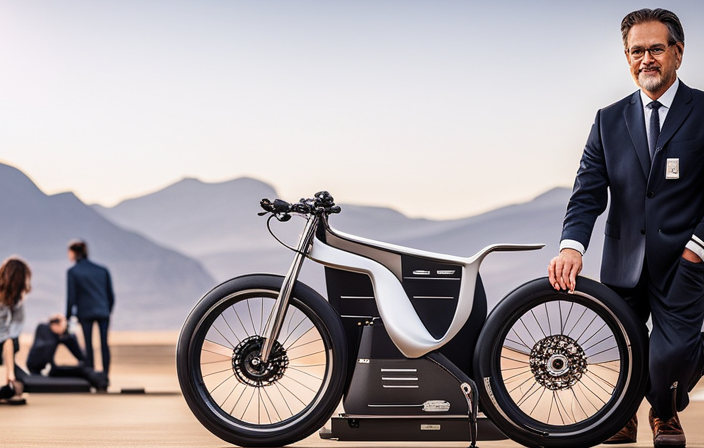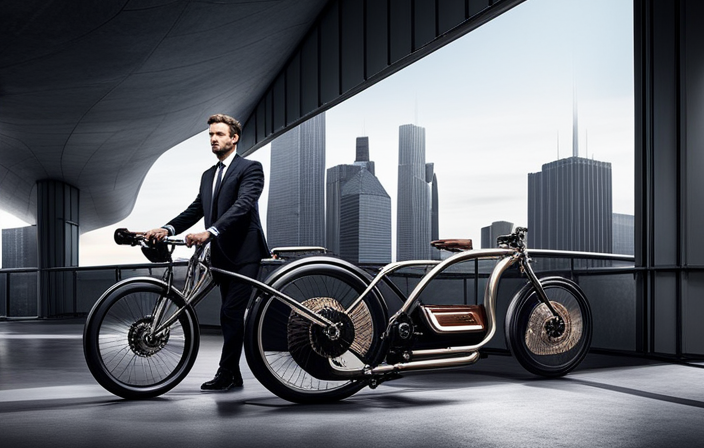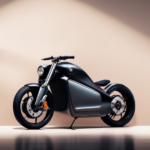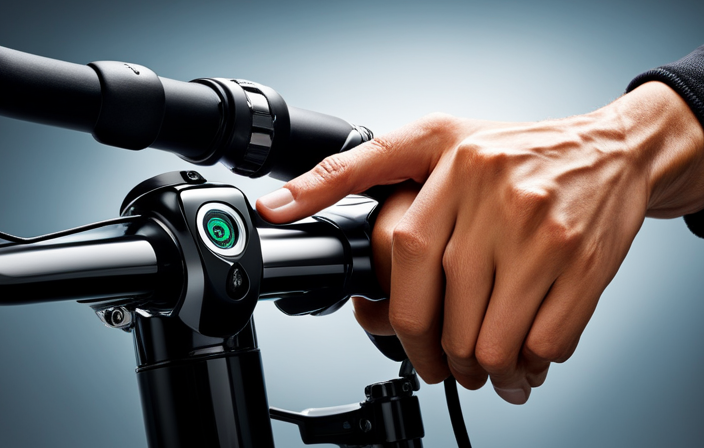Are you tired of your electric bike running out of power in the middle of your ride? Imagine having a battery with a massive capacity, giving you extended range and an improved riding experience.
In this article, we will show you how to create a large capacity battery for your electric bike. By assessing your power needs, gathering the necessary materials, and choosing the right battery cells, you’ll be able to build a battery pack that will keep you going for miles.
Get ready to revolutionize your electric bike experience!
Key Takeaways
- Choose a cool and dry storage location to prevent degradation and extend the lifespan of the battery.
- Follow the manufacturer’s charging instructions to maintain the capacity and overall performance of the battery.
- Regularly inspect the battery for damage and promptly address any issues to prevent further damage.
- Optimize tire pressure, utilize regenerative braking, adjust power assist level, and follow tips for an enhanced riding experience to maximize the efficiency and range of the electric bike.
Assess Your Power Needs
You’ll want to assess your power needs before building a large capacity battery for your electric bike.
To determine the power requirements, start by calculating the wattage of your bike’s motor. This information can usually be found in the manufacturer’s specifications or user manual.
Next, consider the distance you plan to travel on a single charge and the average speed at which you’ll be riding. These factors will help you estimate the amount of energy your battery will need to provide.
Additionally, take into account any additional accessories or features that may require power, such as lights or a horn.
Once you have a clear understanding of your power needs, you can proceed to gather the necessary materials for building your battery.
Gather the Necessary Materials
To gather the necessary materials, start by checking your local hardware store for the items on the list. Here are the essential components you will need:
-
Battery cells: Look for high-capacity lithium-ion cells, such as 18650 cells, which are commonly used in electric vehicles. They offer a good balance between capacity and price.
-
Battery Management System (BMS): This electronic circuit ensures the safe operation and longevity of your battery pack. It monitors each cell’s voltage, controls charging and discharging, and protects against overcharging or overheating.
-
Battery enclosure: Choose a sturdy and compact enclosure that can house your battery pack securely. Look for options that offer good heat dissipation and protection against dust and moisture.
Once you have gathered these materials, you can proceed to the next step of choosing the right battery cells, which will determine the overall capacity and performance of your electric bike’s battery pack.
Choose the Right Battery Cells
When choosing the right cells for your battery pack, it’s important to prioritize a balance between price and performance. There are various types of battery cells available in the market, each with its own pros and cons. To help you make an informed decision, here is a comparison table of five popular battery cell options:
| Cell Type | Energy Density (Wh/kg) | Cycle Life | Cost ($) |
|---|---|---|---|
| Lithium-ion | 150-200 | 500-1000 | Medium |
| Lithium Polymer | 130-150 | 300-500 | High |
| Nickel Metal Hydride (NiMH) | 80-100 | 500-1000 | Low |
| Lead Acid | 30-50 | 300-500 | Low |
| Lithium Iron Phosphate (LiFePO4) | 90-120 | 2000-3000 | High |
Based on your needs, you can choose the battery cell that offers the right balance between energy density, cycle life, and cost. Once you have selected the battery cells, you can move on to determining the battery configuration for your electric bike.
Determine the Battery Configuration
Once you’ve decided on the right battery cells, it’s time to figure out how to configure them for optimal performance. Here are three key considerations to determine the battery configuration:
-
Series Connection: Connecting the battery cells in series increases the voltage of the battery pack. This is crucial for providing the necessary power to your electric bike.
-
Parallel Connection: Connecting the battery cells in parallel increases the capacity of the battery pack. This allows you to ride for longer distances without recharging.
-
Balancing: Ensuring that the voltage and capacity of each cell in the battery pack are balanced is essential for maximizing performance and prolonging the lifespan of the battery.
By carefully considering these factors, you can determine the most efficient configuration for your battery pack.
Now, let’s move on to building the battery pack and bringing your electric bike to life.
Build the Battery Pack
First, gather all the necessary materials for building your battery pack. You will need lithium-ion battery cells, a battery management system (BMS), nickel strips, a spot welder, a soldering iron, heat shrink tubing, and a battery enclosure.
Begin by arranging the battery cells in the desired configuration, ensuring they are properly aligned and connected in series or parallel. Use nickel strips to connect the cells, making sure to maintain a secure and reliable connection. Use a spot welder to weld the nickel strips to the battery terminals.
Next, solder the BMS wires to the appropriate terminals on the battery cells. Insulate the connections with heat shrink tubing to prevent any short circuits.
Install the Battery on Your Electric Bike
To begin, you’ll want to securely attach the battery pack to the frame of your bike using the provided mounting brackets. Make sure to choose a location that is stable and won’t interfere with any moving parts. Once you have determined the ideal position, use the appropriate screws or bolts to fasten the brackets to the frame. Ensure that the battery pack is tightly secured to prevent any shifting or vibrations during your rides.
To emphasize the importance of proper attachment, refer to the table below:
| Mounting Location | Benefits |
|---|---|
| Frame | Provides stability and balance |
| Under the seat | Protects the battery from external elements |
| Rear rack | Offers convenience and easy access |
Test and Calibrate the Battery
Now it’s time for you to check and adjust the battery settings to ensure optimal performance. Start by accessing the battery settings menu on your electric bike’s control panel.
Look for options such as battery capacity, power output, and energy-saving modes. Adjust the battery capacity to match the specifications of your large capacity battery. This will ensure that the bike’s system recognizes the increased capacity and can accurately display the remaining battery life.
Next, adjust the power output to a level that provides a balance between performance and range. Higher power output will drain the battery faster, while lower output may limit the bike’s speed and acceleration.
Monitor Battery Performance
Once you’ve adjusted the settings, it’s important to regularly monitor how the battery is performing.
Monitoring battery performance ensures that you can identify any potential issues or abnormalities early on, allowing you to take appropriate action and maximize the lifespan of your battery.
Keep an eye on the battery’s voltage, current, and temperature readings using a reliable battery monitoring system. Take note of any significant fluctuations or deviations from the normal range, as this may indicate a problem.
Additionally, pay attention to the battery’s charging and discharging cycles, ensuring that they are within the recommended parameters.
By closely monitoring the battery’s performance, you can proactively address any issues and maintain optimal functionality.
This will be crucial to maintaining and caring for your battery in the long run.
Maintain and Care for Your Battery
Remember to regularly clean the terminals of your battery to prevent any buildup that could affect its performance. Maintaining and caring for your battery is crucial to ensure its longevity and optimal functioning. Here are some essential tips to keep your battery in top condition:
| Maintenance Tips | Description |
|---|---|
| Clean the terminals | Remove any dirt, corrosion, or debris from the battery terminals using a battery terminal cleaner or a mixture of baking soda and water. This will ensure a good electrical connection and prevent resistance. |
| Inspect for damage | Regularly check the battery casing for any signs of cracks, leaks, or physical damage. If you notice any issues, it is important to address them promptly to prevent further damage. |
| Store in a cool, dry place | When not in use, store your battery in a cool, dry place away from direct sunlight and extreme temperatures. This will help prevent degradation and extend its lifespan. |
| Charge properly | Follow the manufacturer’s instructions for charging your battery. Overcharging or undercharging can reduce its capacity and overall performance. |
| Regular maintenance | Schedule regular maintenance checks with a professional to ensure your battery is functioning optimally and to address any potential issues proactively. |
Enjoy Extended Range and Improved Riding Experience
To enhance your riding experience and go the extra mile, follow these tips to maximize the range of your electric bike.
-
Optimize your tire pressure: Ensure your tires are properly inflated to the recommended pressure. This reduces rolling resistance and increases efficiency, allowing you to travel further on a single charge.
-
Utilize regenerative braking: Take advantage of regenerative braking technology, which converts the kinetic energy from braking into electrical energy to recharge your battery. This not only extends your range but also helps to prolong the lifespan of your battery.
-
Choose the right level of assistance: Adjust the power assist level on your electric bike based on your riding conditions. Using a lower level of assistance when riding on flat terrain or downhill can conserve battery power, while using a higher level of assistance when tackling uphill climbs can help you conquer challenging terrain without draining your battery excessively.
Conclusion
To conclude, by following the steps outlined in this article, you can successfully create a high-capacity battery for your electric bike.
It is worth noting that with an extended range, you can enjoy a longer riding experience without worrying about running out of power.
According to recent statistics, an electric bike with a large capacity battery can provide an average range of 60-80 miles on a single charge, depending on various factors such as terrain and riding style.
So, with this enhanced battery, you can go further and explore more on your electric bike.
Happy riding!
















